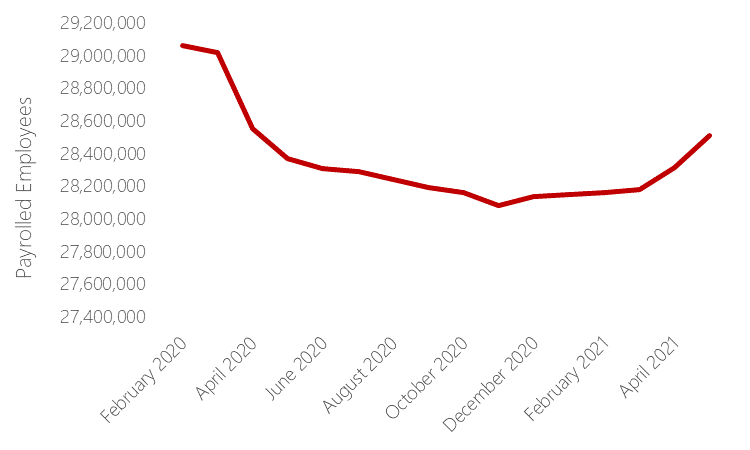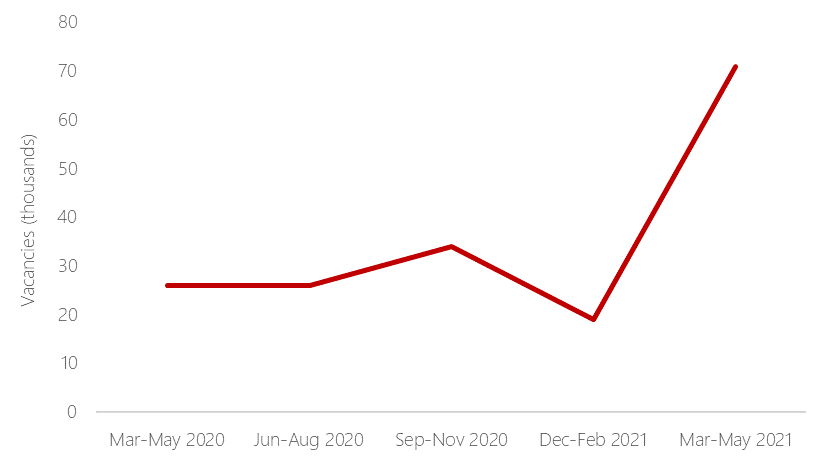Labour market statistics continue to show signs of recovery, but challenges remain
Posted on
 © Photo by Clay Banks on Unsplash
© Photo by Clay Banks on Unsplash
Today’s labour market statistics indicate that, with Covid-19 restrictions easing and more sectors reopening, there are positive signs of recovery in the labour market. HMRC PAYE data shows that the number of employees increased by 197,000 to 28.5 million, although this is still 553,000 lower than pre-pandemic levels.
Figure 1: Payrolled employees, Feb 2020 – April 2021

Source: Work Foundation calculations using ONS & HMRC Dataset: Earnings and employment from Pay As You Earn Real Time Information, seasonally adjusted. 15 June 2021.
Additionally, redundancy levels have dropped back to pre-pandemic levels.
Figure 2: Redundancies, Nov-Jan 2020 – Feb-Apr 2021

Source: Work Foundation calculations using ONS Dataset A01: Unemployment by age and duration (seasonally adjusted) 15 June 2021.
Following a period of employment growth and low unemployment prior to the Covid-19 outbreak, since the start of the pandemic employment had generally been decreasing and unemployment increasing. However, the latest estimates (February to April 2021) continue to show signs of recovery.
Concerningly though, long-term unemployment is up 13% on the quarter and 47% on the year, with 408,000 people now unemployed for more than 12 months. In other words, hundreds of thousands of people who became unemployed immediately prior to the onset of the pandemic have been unable to re-enter the labour market for over a year now.
What opportunities are available?
This will present a significant policy challenge in the months and years ahead. The good news is that vacancies overall have increased to 758,000, which is just 27,000 below the level before the coronavirus (COVID-19) pandemic (January to March 2020). Most industries are now showing vacancies above pre-pandemic levels. This quarter, vacancies in retail are up 28%, and vacancies in arts, entertainment and recreation have more than doubled to 18,000. There has been a particularly steep rise in vacancies in accommodation and food services, increasing by 274% on the quarter, reflecting the easing of restrictions in April.
Figure 3: Change in accommodation and food services vacancies, on year

Source: Work Foundation calculations using ONS Dataset A01: Unemployment by age and duration (seasonally adjusted) 15 June 2021.
This clearly illustrates the exceptional nature of what has happened in the hospitality sector throughout the pandemic. This bounce back is dependent on the successful management of the virus, and any further delays or reversals to the roadmap out of lockdown will likely hit this sector hard.
Supporting people back into work
However, with both the Bank of England and the Office for Budget Responsibility expecting the peak of unemployment to come later this year, when the Government end the Coronavirus Job Retention Scheme in September, now is not the time to be complacent. While the data suggests that there are now more opportunities to get people back into the labour market, going forward the main challenge will be connecting workers with the right vacancies for them, and ensuring that they have the skills required to access them.
The Government’s flagship Restart programme aims to do this, by providing enhanced support for Universal Credit claimants who have been out of work for at least 12 months to find jobs in their local area. While it is too early to evaluate the success of this programme, it is vital that outcomes are closely monitored and support can be quickly ramped up when needed.
Additionally, evidence shows that rising unemployment could have lasting consequences for job quality, particularly for the lower-paid workers who have borne the brunt of Covid-19-related job losses and pay cuts. Government should prioritise improving rights and working conditions for these workers, by bringing the Employment Bill back into the agenda as part of a long-term economic recovery strategy that truly benefits all.
Disclaimer
The opinions expressed by our bloggers and those providing comments are personal, and may not necessarily reflect the opinions of Lancaster University. Responsibility for the accuracy of any of the information contained within blog posts belongs to the blogger.
Back to blog listing

